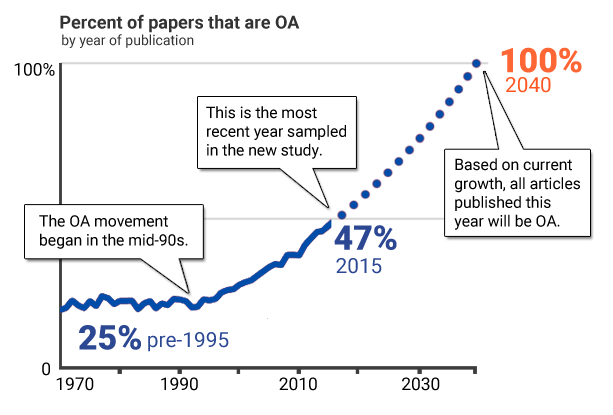There’s always b een a wonderful connection between altmetrics and open science.
een a wonderful connection between altmetrics and open science.
Altmetrics have helped to demonstrate the impact of open access publication. And since the beginning, altmetrics have excited and provoked ideas for new, open, and revolutionary science communication systems. In fact, the two communities have overlapped so much that altmetrics has been called a “school” of open science.
We’ve always seen it that way at Impactstory. We’re uninterested in bean-counting. We are interested in setting the stage for a second scientific revolution, one that will happen when two open networks intersect: a network of instantly-available diverse research products and a network of comprehensive, open, distributed significance indicators.
So along with promoting altmetrics, we’ve also been big on incentives for open access. And today we’re excited that we got a lot better at it.
We’re launching a new Open Access badge, backed by a really accurate new system for automatically detecting fulltext for online resources. It finds not just Gold OA, but also self-archived Green OA, hybrid OA, and born-open products like research datasets.
A lot of other projects have worked on this sticky problem before us, including the Open Article Gauge, OACensus, Dissemin, and the Open Access Button. Admirably, these have all been open-source projects, so we’ve been able to reuse lots of their great ideas.
Then we’ve added oodles of our own ideas and techniques, along with plenty of research and testing. The result? Impactstory is now the best, most accurate way to automatically assess openness of publications. We’re proud of that.
And we know this is just the beginning! Fork our code or send us a pull request if you want to make this even better. Here’s a list of where we check for OA to get you started:
- The Directory of Open Access Journals to see if it’s in their index of OA journals,
- CrossRef’s license metadata field, to see if the publisher has uploaded an open license.
- Our own custom list DOI prefixes, to see if it’s in a known preprint repo
- DataCite, to see if it’s an open dataset.
- The wonderful BASE OA search engine to see if there’s a Green OA copy of the article.
- Repository pages directly, in cases where BASE was unable to determine openness.
- Journal article pages directly, to see if there’s a free PDF link (this is great for detecting hybrid OA)
What’s it mean for you? Well, Impactstory is now a powerful tool for spreading the word about open access. We’ve found that seeing that openness badge–or OH NOES lack of a badge!–on their new profile is powerful for a researcher who might otherwise not think much about OA.
So, if you care about OA: challenge your colleagues to go make a free profile and see how open they really are. Or you can use our API to learn about the openness of groups of scholars (great for librarians, or for a presentation to your department). Just hit the endpoint http://impactstory.org/u/someones_orcid_id to find out the openness stats for anyone.
Hit us up with any thoughts or comments, and enjoy!



